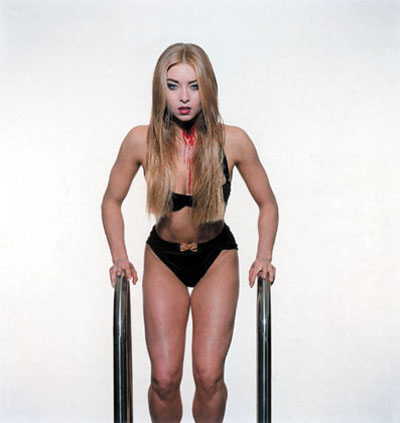 Inez van Lamsweerde: "Sandra", 1992 "Strip & Tease" nudity with something else Paul Blanca, Anton Corbijn, Colin Cook, Fabien de Cugnac, Paul Glazier, Mitsy Groenendijk, Michael Halsband, Mark Jones, Richard Kern, Juk-Lin Tang, Alex McQuilkin, Russ Meyer, Michel Moers, Hanna Sahar, Judith Samen, Pépé Smit, Annie Sprinkle, Inez van Lamsweerde, Eugene von Bruenchenhein, Dana Wyse In a recent book, Le Nouvel ordre sexuel, the French journalist Christian Authier studies the omnipresence of sex in the current public debate and the accompanying transformation of exhibitionism and the violence inherent in sadomasochistic practices into ordinary events. Far from expressing shock at this situation, Authier wonders about the development of a new moral order born of the obligation to be "politically incorrect" and accompanied by the return of true censorship. For example, consider the polemic that surrounded Virginie Despentes's film "Baise-moi" ("Fuck me!") (giving the film an X rating meant its commercial death). As these lines were being written, Jan Hoet got eleventh-hour permission to open the exhibition "Black Low" (renamed Die Ruine einer Ausstellung – The ruins of an exhibition – for the circumstance), by the Norwegian Bjarne Melgaard, at the MARTa in Herford (The town's mayor had been shocked by the satanistic references and scenes of sexual violence to the point of banning the exhibition). In this context, the Strip & Tease exhibition organised by the gallery Aeroplastics sheds an interesting light on the place given to eroticism and pornography in contemporary art. Significantly, of the twenty artists represented in the exhibition, the very young Alex McQuilkin takes the genre the farthest with Fucked, a tragicomic video self-portrait in which she tries in vain to put on her make-up in the midst of having sex. Exhibitionism is also on the menu with Pepe Smit who, true to his humour, photographed himself naked, with his head shaved and long blond locks replacing the pubic hair between his spread legs. Judith Samen continues in this same somewhat grotesque vein with a series of staged scenes in which her naked body is confronted with the incongruous presence of various foods, such as flying pears or rusks on her breasts. For Selfportrait as beauty products, Dana Wyse produces a display of soaps, curlers and other hairbrushes, all wrapped in very typical packaging with the author’s effigy on each wrapper. The story does not say whether the hair-covered glove – a visual rebus of a well-known English expression – is also a self-portrait. For his monumental prints, Fabien de Cugnac applies his technique as a photographer of architecture to study the most intimate parts of the body – his or someone els's. Yet the implacable objectivity of his images makes them somehow strangely familiar. At the opposite end of the scale from this meticulous study of the body, Colin Cook evokes the mirages of New Age philosophy. Naked, floating in ethereal azure, reduced to the size of a newborn, the artist encourages us to find our child souls, before crash-landing in the reality of more down-to-earth daily life. As a genuine icon of the sexual liberation and holder of a PhD in human sexuality, Annie Sprinkle quite naturally has a choice place in the exhibition. Her playing cards mix self-portraits and portraits of photographers and actresses in the pornography industry. Whores are my heroes recalls the artist's militant activism in favour of prostitutes, whereas Transformation salon shows that the right accessories and make-up can turn the most ordinary woman into a sexual bombshell in front of the camera’s lens. Other musts are Russ Meyer and Richard Kern, who appear as pioneers in reconnoitring a form of eroticism that proclaims its popular roots, roots to be found in magazines and "B movie" skin flicks. This is also the approach of the painter Mark Jones, whose quick, expressive style serves realistic imagery and heroic vulgarity. This way of transcending the sordid is found in the photographs of cross-dressers taken in the streets of a Tel Aviv suburb at night by Hannah Sahar or in the pictures taken in the strip joints visited by Anton Corbijn. In a completely different register, Inez van Lamsveerde incarnates the beautifying tendency of a type of eroticism that makes more use of fashion photography, as shown in her magnificent Anastasia. In the same vein, Michael Halsband pays tribute to the beauty of Kim Cattral, the heroine of Sex in the City. The tattooed boy of Paul Glazier's model creates a subtle analogy between the iconography of the work and his technique, that of a print halfway between printing and photography. Paul Blanca, for his part, hijacks most skilfully a commercial genre in which he has already been successful, with a self-portrait of his naked back, the skin branded with a bloody Mickey Mouse. Inspired by the world of advertising and posters, Michel Moers hunts down the "icons" of packaging to recycle them in neo-pop images. Mitsy Groenendijk also talks about consumption with her sexy bras straight out of a kitsch souvenir shop that glorify a range of celebrities such as La Cicciolina, the Beatles and Charles and Diana. Finally, special mention goes to the photographs of Eugene von Bruenchenhein (1910-1983). This lowly clerk from Marinette, Wisconsin, was not only an avid botanist and member of the Milwaukee Cactus Club, but also an amateur photographer. The several thousand pictures that he took of his wife over more than a decade exude a discreet eroticism tinged with exoticism in staged scenes that were intended to be odes to her beauty. (Text: Pierre-Yves Desaive) Ausstellungsdauer: 24.5. - 13.7.2002 Öffnungszeiten: Mi-Sa 14 - 18 Uhr und nach telefonischer Verabredung aeroplastics contemporary Rue Blanche 32 / Blanchestraat B-1060 Brüssel Telefon +32 2 537 22 02 Fax +32 2 537 15 49 E-Mail aeroplastics@brutele.be www.aeroplastics.net |